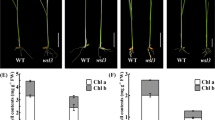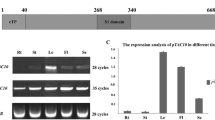Abstract
Nucleoids were purified from chloroplasts of dividing soybean cells and their polypeptide composition analyzed by SDS-polyacrylamide gel electrophoresis. Of the 15–20 nucleoid-associated polypeptides, several demonstrated DNA binding activity. Upon disruption of the nucleoids with high concentrations of NaCl, a subset of these proteins and the majority of chloroplast DNA were recovered in the supernatant after centrifugation. Removal of the salt by dialysis resulted in formation of nucleoprotein complexes resembling genuine nucleoids. Purification of these structures revealed three major proteins of 68, 35 and 18 kDa. After purification of the 68 kDa protein to homogeneity, this protein was able to compact purified chloroplast DNA into a nucleoid-like structure in a protein concentration-dependent fashion. Addition of the 68 kDa protein to an in vitro chloroplast DNA replication system resulted in complete inhibition of nucleotide incorporation at concentrations above 300 ng of 68 kDa protein per μg of template DNA. These results led to in situ immunofluorescence studies of chloroplasts replicating DNA which suggested that newly synthesized DNA is not co-localized with nucleoids. Presumably, either the plastid replication machinery has means of removing nucleoid proteins prior to replication or the concentration of nucleoid proteins is tightly regulated and the proteins turned over in order to allow replication to proceed.
Similar content being viewed by others
References
Bailey II JC: Studies of the chloroplast DNA polymerase: Association of exonucleases, processivity, fidelity, and identification of the catalytically active polypeptide. Dissertation, University of Southern Mississippi (1997).
Baumgartner BJ, Mullet JE: Plastid DNA synthesis and nucleic acid-binding proteins in developing barley chloroplasts. J Photochem Photobiol 11: 203–218(1991).
Bradford MM: A rapid and sensitive method for the quantitation of microgram quantities of protein utilizing the principle of protein-dye binding. Anal Biochem 72: 248–254(1976).
Briat J-F, Gigot C, Laulhere JP, Mache R: Visualization of a spinach plastid transcriptionally active DNA-protein complex in a highly condensed structure. Plant Physiol 69: 1205–1211 (1982).
Briat J-F, Létoffe S, Mache R, Rouviè re-Yaniv J: Similarity between the bacterial histone-like protein HU and a protein from spinach chloroplasts. FEBS Lett 172: 75–79(1984).
Briat J-F, Mache R: Properties and characterization of a spinach chloroplast RNA polymerase isolated from a transcriptionally active DNA-protein complex. Eur J Biochem 111: 503–509(1980).
Cannon GC, Heinhorst S, Weissbach A: Organellar DNA synthesis in permeabilized soybean cells. Plant Mol Biol 7: 331–341(1986).
Davies JP, Thompson RJ, Mosig G: Intercalation of psoralen into DNA of plastid chromosomes decreases late during barley chloroplast development. Nucl Acids Res 19: 5219–5225 (1991).
Grasser KD, Ritt C, Krieg M, Fernández S, Alonso JC, Grimm R: The recombinant product of the Cryptomonas 8 plastid gene hlpA is an architectural HU-like protein that promotes the assembly of complex nucleoprotein structures. Eur J Biochem 249: 70–76(1997).
Hansmann P, Falk H, Ronai K, Sitte P: Structure, composition and distribution of plastid nucleoids in Narcissus pseudonarcissus. Planta 164: 459–472(1985).
Hashimoto H: Changes in distribution of nucleoids in developing and dividing chloroplasts and etioplasts of Avena sativa. Protoplasma 127: 119–127(1985).
Hedrick LA, Heinhorst S, White MA, Cannon GC: Analysis of soybean chloroplast DNA replication by two-dimensional gel electrophoresis. Plant Mol Biol 23: 779–792(1993).
Heinhorst S, Cannon GC, Weissbach A: Chloroplast and mitochondrial DNA polymerases from cultured soybean cells. Plant Physiol 92: 939–945(1990).
Horn ME, Sherrard JJ, Widholm JM: Photoautotrophic growth of soybean cells in suspension culture. Plant Physiol 72: 426–429 (1983).
Itoh R, Takahashi H, Toda K, Kuroiwa H, Kuroiwa T: DNA gyrase involvement in chloroplast-nucleoid division in Cyanidioschyzon merolae. Eur J Cell Biol 73: 252–258(1997).
Kuroiwa T: The replication, differentiation, and inheritance of plastids with emphasis on the concept of organelle nuclei. Int Rev Cytol 128: 1–62(1991).
Laemmli UK: Cleavage of structural proteins during the assembly of the head of bacteriophage T4. Nature 227: 680–685 (1970).
Liu J-W, Rose RJ: The spinach chloroplast chromosome is bound to the thylakoid membrane in the region of the inverted repeat. Biochem Biophys Res Comm 184: 993–1000(1992).
MacAlpine DM, Perlman PS, Butow RA: The high mobility group protein Abf2p influences the level of yeast mitochondrial DNA recombination intermediates in vivo. Proc Natl Acad Sci USA 95: 6739–6743(1998).
Mullet JE: Chloroplast development and gene expression. Annu Rev Plant Physiol 39: 475–502(1988).
Murphy LD, Zimmerman SB: Stabilization of compact spermidine nucleoids from Escherichia coli under crowded conditions: implications for in vivo nucleoid structure. J Struct Biol 119: 336–346(1997).
Nakano T, Murakami S, Shoji T, Yoshida S, Yamada Y, Sato F: A novel protein with DNA binding activity from tobacco chloroplast nuclei. Plant Cell 9: 1673–1682(1997).
Nakano T, Sato F, Yamada Y: Analysis of nucleoid-proteins in tobacco chloroplasts. Plant Cell Physiol 34: 873–880(1993).
Nemoto Y, Kawano S, Kondoh K, Nagata T, Kuroiwa T: Studies on plastid-nuclei (nucleoids) in Nicotiana tabacum L. III. Isolation of chloroplast-nuclei from mesophyll protoplasts and identification of chloroplast DNA-binding proteins. Plant Cell Physiol 31: 767–776(1990).
Nemoto Y, Kawano S, Nagata T, Kuroiwa T: Studies on plastid-nuclei (nucleoids) in Nicotiana tabacum L. IV. Association of chloroplast-DNA with proteins at several specific sites in isolated chloroplast-nuclei. Plant Cell Physiol 32: 131–141 (1991).
Nemoto Y, Kawano S, Nakamura S, Mita T, Nagata T, Kuroiwa T: Studies on plastid-nuclei (nucleoids) in Nicotiana tabacum L.I. Isolation of proplastid-nuclei from cultured cells and identification of proplastid-nuclear proteins. Plant Cell Physiol 29: 167–177(1988).
Nemoto Y, Nagata T, Kuroiwa T: Studies on plastid-nuclei (nucleoids) in Nicotiana tabacum L. II. Disassembly and reassembly of proplastid-nuclei isolated from cultured cells. Plant Cell Physiol 30: 445–454(1989).
Nerozzi AM, Coleman AW: Localization of plastid DNA replication on a nucleoid structure. Am J Bot 84: 1028–1041 (1997).
Newman SM, Zelenaya-Troitskaya O, Perlman P, Butow R: Analysis of mitochondrial DNA nucleoids in wild-type and a mutant strain of Saccharomyces cerevisiae that lacks the mitochondrial HMG box protein Abf2p. Nucl Acids Res 24: 386–393(1996).
Pettijohn DE:Histone-like proteins and bacterial chromosome structure. J Biol Chem 263: 12793–12796(1988).
Reiss T, Link G: Characterization of transcriptionally active DNA-protein complexes from chloroplasts and etioplasts of mustard (Sinapis alba L.). Eur J Biochem 148: 207–212 (1985).
Rose RJ, Cran DG, Possingham JV: Changes in DNA synthesis during cell growth and chloroplast replication in greening spinach leaf disks. J Cell Sci 17: 27–41(1975).
Rose RJ, Lindbeck AGC: Morphological studies on the transcription of spinach chloroplast DNA. Z Pflanzenphysiol 106: 129–137(1982).
Sato N, Albrieux C, Joyard J, Douce R, Kuroiwa T: Detection and characterization of a plastid envelope DNA-binding protein which may anchor plastid nucleoids. EMBO J 12: 555–561(1993).
Sato N, Oshihima K, Watanabe A, Ohta N, Nishiyama Y, Joyard J, Douce R: Molecular characterization of the PEND protein, a novel bZIP protein present in the envelope membrane that is the site of nucleoid replication in developing plastids, Plant Cell 10: 859–872(1988).
Widholm JM: Properties and uses of photoautotrophic plant cell cultures. Int Rev Cytol 132: 109–175(1992).
Williams R, Rimsky S: Molecular aspects of the E. coli nucleoid protein, H-NS: a central controller of gene regulatory networks. FEMS Lett 156: 175–185(1997).
Author information
Authors and Affiliations
Rights and permissions
About this article
Cite this article
Cannon, G.C., Ward, L.N., Case, C.I. et al. The 68 kDa DNA compacting nucleoid protein from soybean chloroplasts inhibits DNA synthesis in vitro. Plant Mol Biol 39, 835–845 (1999). https://doi.org/10.1023/A:1006135615924
Issue Date:
DOI: https://doi.org/10.1023/A:1006135615924




